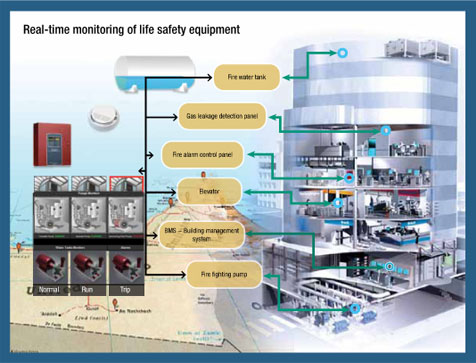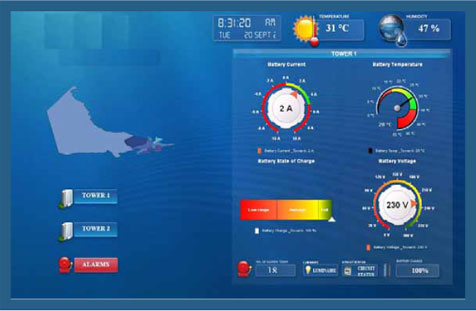
Emergency Systems
Manufacturers can continuously monitor the health status of all the fire and safety equipment they have supplied and offer services to co-ordinate regular testing of alarms and other safety equipment from a central control room

ICT has a role to play and Pacific Controls innovative system uses the very latest AI to suppress false alarms and keep track of emergency vehicles so that the most appropriate crew is dispatched to any incident as fast as possible.
Suppliers of fire alarms and emergency equipment can use Pacific Controls ICT Enabled Managed Services for Business Process Integration to offer their customers tighter integration with life and safety systems and improved monitoring and control. Using the service for monitoring of safety systems’ and early fire detection can improve the overall safety of buildings and communities. The service connects fire, lift, and other types of emergency alarms to Pacific Controls GCCC using M2M wireless technology. The GCCC remotely monitors the alarms, in real time 24x7x365, assesses the life and safety issue at the site and directs first responders nearest to the site to tackle the situation.
Emergency alarm systems, such as fire and elevator alarms, can be connected to the Galaxy platform for proactive monitoring to ensure that the system is working at all times and that false alarms are tracked. Manufacturers can continuously monitor the health status of all the fire and safety equipment they have supplied and offer services to co-ordinate regular testing of alarms, firefighting and other safety equipment from a central control room. This ensures that systems are always active and functioning properly.
M2M delivers cost-effective alarm monitoring

Wireless communications are being widely adopted for direct alarm solutions due to the falling installation costs and the increasing levels of standardisation and redundancy available. Advances in M2M technology offer the real-time communication, security and reliability required for building alarm systems. Interoperability is now possible between various monitoring devices, communication protocols and data transfer technologies to achieve an ultra-large-scale citywide installation. M2M wireless connectivity provides capabilities that were not possible with earlier technology, including the ability to scale M2M networks to the very large sizes needed. A public safety system requires the ability to configure thousands of sites to be monitored simultaneously from a central command control center.
There are variety of fire alarm and firefighting systems in buildings today and the integration of all these systems with a single control platform was, up until now, a challenge.
Pacific Controls solution uses multiple protocols to connect any system regardless of make and model and is capable of integration with any third party and legacy system. The distributed architecture also allows access points to be added easily. Pacific Controls installs a data server panel and a digital cellular communication device at the sites to be monitored, which are connected to the alarm systems in the building and relay data directly to the GCCC using wireless data M2M transmission. The data server panel can interface with a diverse range of Integrated Business Management Systems (IBMS) available across various buildings through Ethernet cables or three wire RS485 interfaces.
The service connects most types of building alarms:
- Fire alarms
- Elevator alarms
- Gas leakage alarms
- Safety equipment malfunction
- Power interruption
- Low water level in reservoirs
- Firefighting pump run alarms and malfunctions
Pacific Controls State-of-the-Art Crisis Management System

The life and safety monitoring market is driven by the availability of new technology and the continuing search to provide new and more advanced monitoring services. Pacific Controls Operations Manager is a leading state-of- the-art global crisis management system for life and safety alarm monitoring, currently being used by public safety organisations and the security industry with proven improvement in response times.
The platform includes an integrated suite of tools for managing project and staff performance, using a framework of goals, action plans and results. It has the most up-to-date alarm monitoring software system in the world which handles all types of electronically generated alarms including emergency, security, and fire alarms. The multilingual system helps the alarm operator to react swiftly and correctly, aided by the pre-configured actions built into the system. The Operations Manager alarm monitoring system has been designed and developed from scratch using leading development tools. The software supports multiple receiver types and can process large volumes of simultaneous alarm signals.
By only having one database to update, one system for operators to learn and use and one system for comprehensive reporting, alarm handling becomes more efficient, administration time is reduced and training requirements simplified.
By only having one database to update, one system for operators to learn and use and one system for comprehensive reporting, alarm handling becomes more efficient, administration time is reduced and training requirements simplified.
The design philosophy is ‘Complexity Made Simple’. Operations Manager performs highly complex tasks in a way that requires no specialist operator knowledge. Drop down menus, obscure task bar icons and data trees are avoided in the focus to create a user-driven design. Operator screens can be configured according to the skill of the operator. Operations Manager is a scalable solution with no limit to the number of accounts and workstations. As all of these services are handled within one user interface and a single Microsoft SQL database, minimal additional operator training is needed and management reports are generated in a standard format.
Main features:
- Easy to use graphical user interface, making it intuitive and easy to use
- Fully-customisable user interface can be adapted to the skill level of the operator
- Reduced number of clicks to action alarms, improving speed and accuracy of response
- Integrated to the call management system for calling emergency numbers on the click of a button
- Scalable to an unlimited number of connections and an unlimited number of operators
- Graphical maps and plans
- Customer event log provides full audit trail of all events
- Management reporting with criteria filtering and e-mail delivery
- Remote web access for customers
- Low initial system investment and protected future growth path
- Minimal user training requirement simplifies staff resourcing
- Helps deliver a high level of customer service and responsiveness
- Easy to maintain in use with automated back-up and recovery
- Allows total administrative control over the system and the data
- Options of a simple priority-based alarm queue with auto or manual alarm retrieval, or comprehensive alarm queue filtering on a number of variables
- Customer database with powerful, multiple-field search and selection
- Customer notes and comments for special procedures and instructions
- Comprehensive 24x7x365 service and technical and user support.
Integrated Emergency Fleet Solution
The integration between the Operations Manager and Fleet Management solution has been shown to result in better oversight and a remarkable increase in efficiency. The integrated map displays both the position of the incident and the nearest Civil Defence vehicles. Using this map, the dispatcher sends the alarm information including GPS coordinates with a click of a mouse to the nearest vehicle for immediate dispatch. The information is displayed on a GPS navigation system in the vehicle and the driver is navigated to the location of the emergency.
Main features:
- Display of site and vehicles on the same map
- Organise and send assignments to vehicles
- Free text from vehicles to alarm receiving center and vice versa
- Logging of communication between alarm center and vehicles
- Display of time specified route for a vehicle on a digital map in the alarm center
- Calculation and display of route to destination in vehicles.
The Emergency Management System is Cost-Effective and Flexible
The initial system investment required is kept low by the hosted model, and the future growth path is protected, with cost linked to the number of sites and vehicles covered. The training requirement is kept to the minimum because the system is designed using the most advanced techniques to ensure usability, and the unified system simplifies the user interfaces, this allows more flexibility in staffing the operations center.
Usage costs are low, because Pacific Controls maintain excellent commercial relationships with a number of major GSM/GPRS service providers and can arrange competitive data tariffs throughout the world through its partner networks. These relationships, together with the capability of the M2M units to compress data to save packet volume, enable Pacific Control to offer highly competitive fixed monthly charges for the data tariffs.
Pacific Controls Service Saves Lives and Saves Money
To obtain the full benefit of Pacific Controls ICT Enabled Managed Services for Business Process Integration for emergency management, it is paramount that relationships between emergency services and other response agencies are established well in advance of the occurrence of an emergency. Once this is in place, by leveraging the features of the GCCC, organisations will be able to ensure seamless transition from one level of response to the next, as the situation requires. Standard operating procedures (SOPs) are developed and embedded in close consultation with the responding agencies to ensure timely sharing of information and effective and efficient operations.
Unreliable life and safety systems, which can result in a delayed response to emergency situations, both increase costs to the organisations associated with dealing with false alarms and also add costs to the wider economy through loss of life and assets. Deploying Pacific Controls’ life and safety solution brings dramatic benefits, including a reduction in lives lost and in the number of serious fires, as well as cost savings from more efficient operation of the emergency services staff and vehicles.
Benefits to Alarm system suppliers
In addition to costs saved in responding to emergencies, the vehicle tracking solution from Pacific Controls allows managers to control their fleet more efficiently, to improve time management, reduce fuel bills and overtime costs and also to reduce the number and cost of mobile calls between drivers and dispatchers. The vehicle tracking system also improves staff safety and vehicle security, while ensuring that the fleet managers meet their duty of care to their staff and comply with legislation relating to length of shifts.
Once a site is connected, remote monitoring of the life and safety systems by Pacific Controls, combined with site visits, give the safety authorities an opportunity to capture snags in the building systems. Pacific Controls continuously ensures that any system or panel faults are cleared expeditiously. The reporting system ensures that all issues are followed up and overdue actions are identified.
Pacific Controls Managed Services for Critical Assets Monitoring ensure that customer satisfaction levels are maintained at all times. The company believes that, by automating mundane tasks, service personnel are able to focus on managing in-person customer relations more effectively, thereby maximising employee productivity. Service follow-up by trained customer service professionals also ensures minimal downtime and continuity of protection.
Benefits to the Emergency Services
One of the main benefits delivered by the Pacific Controls system is the immediate report that can be produced for the emergency control center, detailing the layout of the building, the location of the alarm, the escape routes and the nearest emergency vehicles. This data can be sent to the first response vehicles at the click of a mouse, all of which helps to save precious time.
False alarms represent an enormous waste of resources for the emergency services, businesses and the public. Pacific Controls innovative services have achieved a significant reduction in the number of false alarms through the increased reliability of alarm systems. This has the beneficial effects of increasing the level of public compliance with life and safety systems, as well as reducing the economic and social costs associated with responding to false and unwanted fire alarm activations.
Response time to genuine emergencies is reduced and, because the first responders arrive at the scene earlier, fires (and the destruction caused by them) have been smaller than was the case before. The policy of verifying all alarms with onsite contact persons has also enabled the reduction of the overall expenditure on mobilisation of first responders. Who, therefore, have more time available to carry out other duties, reducing the overall cost of running the service.
The provision of detailed and timely reports to senior managers also improves visibility of issues relating to the provision of the emergency services and allows better strategic decision making.
Benefits to Citizens and Building Owners
Citizens and owners of buildings and businesses gain peace of mind from knowing that the emergency services will respond swiftly to any alarms. The community benefits from a reduction in the number of serious fires and the consequent reduction in loss of lives and of goods and possessions.

